November 27, 2024 · 11 min read
How to Build Collaborative Educational Partnerships Across Institutions

Shaimaa Badawi
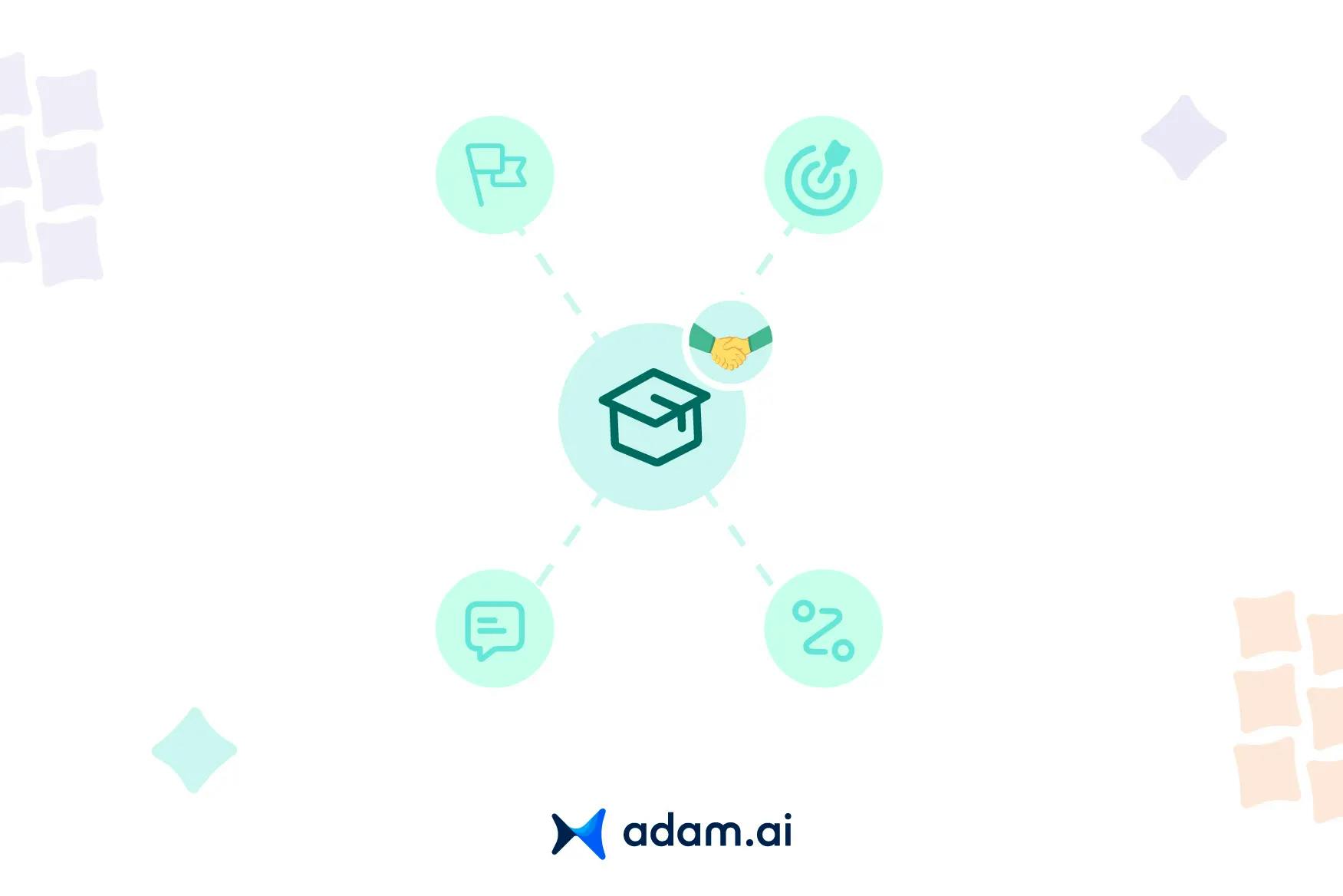
Educational institutions are finding new ways to collaborate and thrive together. Cross-institutional partnerships are reshaping the future of education, fostering innovation, and tackling challenges that individual institutions can't solve alone. This article dives into the defining characteristics of successful partnerships, the transformative role of technology, and the best practices for sustaining collaborations that make a difference.
What are the characteristics of effective collaborative educational partnerships?
Effective collaborative educational partnerships thrive on certain key characteristics that enable institutions to work together seamlessly and achieve shared goals. These characteristics include the following:
1. Shared vision and goals
Effective partnerships begin with a clear, mutual understanding of objectives. Institutions must align their goals to create a shared vision that serves all stakeholders. This ensures everyone involved is working towards the same outcomes, whether it’s improving student performance, enhancing curricula, or addressing larger societal challenges like sustainability.
2. Strong leadership and governance
Leaders must foster inclusivity, build trust among stakeholders, and establish governance structures that support collaboration. This includes appointing steering committees or advisory boards that represent diverse interests, ensuring fair decision-making processes.
3. Open and transparent communication
Regular meetings, progress updates, and feedback loops help maintain trust and ensure all parties are informed about developments. This is especially crucial when institutions from different sectors collaborate, as it bridges gaps in organizational cultures and expectations.
4. Mutual benefit and reciprocity
Successful partnerships ensure that all parties gain value, whether through knowledge sharing, resource pooling, or capacity building. Reciprocity strengthens commitment, as stakeholders are more likely to invest effort when they see tangible benefits.
5. Adaptability and flexibility
Effective partnerships remain flexible, adjusting their strategies to meet evolving needs or challenges. For example, during the COVID-19 pandemic, many educational partnerships pivoted to virtual collaboration to maintain their goals.
6. Sustainability and long-term planning
Sustainability ensures that partnerships endure beyond initial phases. This includes securing funding, institutionalizing collaborative practices, and embedding the partnership’s goals into long-term organizational strategies.
7. Leveraging technology for collaboration
Modern partnerships increasingly rely on technology to facilitate communication, data sharing, and project management. Centralized collaboration platforms provide institutions with efficient tools to manage meetings, document progress, and streamline workflows while enhancing accountability.
8. Inclusivity and equity
Effective collaborations prioritize inclusivity, ensuring all voices, especially underrepresented groups, are heard. This diversity fosters richer dialogue and more innovative solutions, benefiting the partnership and its broader impact.
Why are cross-sector partnerships critical for educational advancement?
Cross-sector partnerships are critical for educational advancement because they bring together diverse expertise, resources, and perspectives to address complex challenges and create innovative solutions. Here's why these partnerships are important:
1. Resource sharing and optimization
Educational institutions often face limited budgets and resources. Partnerships with external sectors provide access to additional funding, infrastructure, and expertise. For example, collaborations with businesses or government agencies can introduce cutting-edge technologies, specialized training, and financial support, which are often beyond the reach of single institutions.
2. Real-world relevance and skill alignment
Cross-sector partnerships help align educational programs with the practical needs of industries and communities. By integrating real-world experiences, such as internships, apprenticeships, or joint research initiatives, students gain skills that are directly applicable to the workforce, improving their employability and ensuring education remains relevant.
3. Innovation and knowledge transfer
Collaborations foster the exchange of ideas and innovations across sectors. For instance, partnerships between educational institutions and technology companies can drive advancements in teaching methods, such as integrating AI or virtual reality into classrooms. These innovations not only enhance learning experiences but also prepare students to navigate a rapidly evolving world.
4. Addressing societal challenges
Many societal issues, such as sustainability, inequality, and public health, require interdisciplinary approaches. Cross-sector partnerships leverage the strengths of various organizations to create holistic solutions. For example, an alliance between schools, healthcare providers, and community organizations can implement programs that address students’ physical and mental well-being, improving educational outcomes.
5. Promoting equity and inclusion
By collaborating with non-profit organizations and community groups, educational institutions can reach underserved populations and bridge access gaps. Partnerships enable targeted interventions, such as scholarships, mentorship programs, and community-driven projects, which support marginalized students and promote inclusive education.
6. Global competitiveness and economic growth
In a globalized world, cross-sector collaborations prepare students to compete in international markets by exposing them to diverse cultures, industries, and disciplines. These partnerships also contribute to economic growth by creating a skilled workforce that meets the demands of emerging industries.
7. Systemic change and policy influence
Partnerships with government agencies and advocacy groups can drive policy reforms and systemic changes in education. Collaborative efforts often have the scale and influence needed to address structural barriers, ensuring long-term improvements in educational quality and accessibility.
What challenges do institutions face when building cross-institutional collaborations?
Institutions face a variety of challenges when building cross-institutional collaborations, ranging from cultural differences to logistical barriers. Here’s an overview of the main challenges and solutions:
1. Divergent goals and priorities
- Challenge: Partnering institutions often have differing objectives, which can lead to misaligned expectations and conflicts.
- Solution: Establish a shared vision and clearly defined goals early in the collaboration. Open dialogue and agreements, such as Memorandums of Understanding (MOUs), can help align priorities and set measurable objectives.
2. Cultural and operational differences
- Challenge: Differences in organizational culture, decision-making processes, and operational practices can lead to misunderstandings.
- Solution: Foster mutual understanding through workshops, joint training sessions, and regular communication. Building trust and creating an inclusive environment for all partners helps bridge these cultural gaps.
3. Resource and funding constraints
- Challenge: Limited budgets and resources can restrict an institution's ability to commit fully to the collaboration.
- Solution: Identify and pursue external funding opportunities, such as grants or sponsorships. Resource-sharing agreements can also optimize the use of existing assets, reducing financial strain.
4. Leadership and governance issues
- Challenge: Lack of clear leadership or governance structures can result in confusion and inefficiency.
- Solution: Appoint a dedicated leadership team or steering committee to oversee the collaboration. Clear governance structures and decision-making protocols help ensure accountability and smooth coordination.
5. Communication barriers
- Challenge: Poor communication can lead to misinterpretations, delays, and erosion of trust among partners.
- Solution: Implement robust communication strategies, such as regular meetings, centralized platforms for updates, and clearly defined communication channels. Transparent and consistent messaging is key to maintaining trust.
6. Sustainability and continuity
- Challenge: Partnerships often lose momentum due to staff turnover, changing priorities, or lack of long-term planning.
- Solution: Institutionalize the collaboration by embedding it into organizational strategies and policies. Create mechanisms for onboarding new stakeholders and maintaining knowledge continuity, such as documentation and training programs.
7. Regulatory and policy constraints
- Challenge: Legal, regulatory, or policy differences between institutions can slow down or complicate collaboration.
- Solution: Engage legal advisors early in the process to navigate regulatory challenges. Develop agreements that address compliance issues and outline roles and responsibilities.
8. Lack of stakeholder engagement
- Challenge: Resistance or lack of interest from stakeholders, including faculty, students, or external partners, can limit the collaboration's impact.
- Solution: Actively involve stakeholders in planning and decision-making processes. Highlight the mutual benefits of the partnership and address concerns proactively to foster buy-in and support.
How can technology enhance collaboration across educational institutions?
Technology plays a transformative role in enhancing collaboration across educational institutions by streamlining communication, improving resource sharing, and fostering innovation. Here’s how:
1. Centralized communication platforms
Technology enables real-time communication through platforms like video conferencing tools, instant messaging apps, and collaborative workspaces. These tools eliminate geographical barriers, allowing institutions to hold virtual meetings, share updates, and discuss strategies efficiently.
2. Shared digital workspaces
Cloud-based platforms allow institutions to share documents, data, and resources seamlessly. Tools like shared drives and project management software ensure that all partners have access to up-to-date information, promoting transparency and collaborative problem-solving.
3. Data integration and analytics
Advanced data management systems aggregate and analyze information from multiple institutions. This allows for informed decision-making by identifying trends, tracking progress, and measuring the impact of collaborative initiatives. For instance, institutions can assess student outcomes across partners to refine educational strategies.
4. Virtual learning environments
Collaborative virtual learning platforms connect students and faculty across institutions, enabling joint courses, webinars, and workshops. These environments provide access to a broader range of expertise and resources, enhancing educational opportunities for learners.
5. AI-powered collaboration tools
Artificial intelligence enhances collaboration by automating routine tasks, such as scheduling meetings or summarizing discussions. AI-driven insights also help identify areas for improvement, optimize workflows, and personalize learning experiences across institutions.
6. Streamlined project management
Technology simplifies project management by offering tools to assign tasks, set deadlines, and track milestones. These tools ensure accountability and keep collaborative projects on schedule, even when involving multiple stakeholders.
7. Resource sharing and accessibility
Digital libraries, repositories, and open educational resources enable institutions to share academic materials and research findings. This democratizes access to knowledge and reduces duplication of efforts, allowing partners to focus on innovation.
8. Scalable collaboration models
Technology supports scalability by accommodating partnerships of varying sizes and complexities. From small-scale collaborations to global networks, digital solutions adapt to the needs of different stakeholders, ensuring continuity and growth.
What are the best practices for maintaining sustainability in educational partnerships?
Maintaining sustainability in educational partnerships requires intentional planning, regular evaluation, and fostering mutual commitment. These best practices help ensure that partnerships remain effective and impactful over time:
1. Establish clear goals and objectives
Defining a shared vision and setting measurable objectives at the outset creates a strong foundation. Clear goals ensure all partners understand the purpose of the collaboration and their roles in achieving its outcomes.
2. Embed collaboration into institutional policies
Institutionalizing the partnership by embedding it into strategic plans, policies, and curricula ensures continuity. This minimizes the risk of the partnership dissolving due to leadership changes or shifting priorities.
3. Ensure mutual benefit
Sustainable partnerships must provide value to all stakeholders. Regularly assess and adapt the collaboration to ensure it meets the evolving needs of each partner, whether it’s through resource sharing, skill development, or community impact.
4. Secure long-term funding
Identify and pursue sustainable funding sources, such as grants, sponsorships, or government programs. Diversifying funding streams reduces reliance on any single source and ensures financial stability for the partnership.
5. Foster strong communication
Regular and transparent communication builds trust and ensures all partners remain aligned. Use centralized platforms for updates, reports, and decision-making, and hold regular check-ins to address challenges promptly.
6. Develop leadership continuity plans
Staff turnover can disrupt partnerships. Establishing leadership continuity plans, such as onboarding processes and detailed documentation, helps maintain momentum when personnel changes occur.
7. Adapt to change
Flexibility is key to sustainability. Regularly review the partnership’s goals and strategies to adapt to new challenges, opportunities, or shifts in the educational landscape.
8. Measure and celebrate success
Tracking progress through key performance indicators (KPIs) and evaluating the impact of the partnership demonstrates value to stakeholders. Celebrating milestones fosters motivation and reaffirms the importance of the collaboration.
What examples demonstrate the impact of well-executed educational partnerships?
Well-executed educational partnerships have demonstrated significant impacts across various domains, from improving student outcomes to fostering innovation. Here are some examples that showcase their transformative potential:
1. Cross-institutional curriculum development
A collaboration between Babson College, Wellesley College, and Olin College of Engineering in Massachusetts highlights how institutions with distinct missions can pool their expertise. By creating shared academic programs, they expanded opportunities for students in entrepreneurship, liberal arts, and engineering, enabling interdisciplinary learning and innovation.
2. Community-driven projects
The Youth Environmental Alliance in Higher Education (YEAH), involving institutions across four countries, focuses on sustainability education. This partnership engages students in climate diplomacy and collaborative projects, empowering them with the skills and knowledge to address global environmental challenges while fostering a sense of global citizenship.
3. Public-private partnerships
In South Africa, a university partnered with agricultural firms to improve sustainability in farming. Joint research projects addressed real-world challenges like pest control and water management, leading to innovative solutions while providing students with hands-on experience and improving industry practices.
4. Shared resources for cost efficiency
In Pennsylvania, a consortium of liberal arts colleges, including Swarthmore and Franklin & Marshall, developed joint faculty development programs and shared administrative services. This collaboration reduced costs and enhanced the quality of education across participating institutions.
5. Technology-driven collaboration
The European Universities Initiative (EUI) connects universities across Europe to create "living labs" for civic engagement and multidisciplinary research. This partnership leverages technology to foster cross-cultural cooperation and equip students with the skills needed for a globalized workforce.
How can adam.ai manage collaborative educational partnerships effectively?
adam.ai can effectively manage collaborative educational partnerships by providing a centralized platform that streamlines communication, organizes meeting knowledge, and enhances decision-making processes. Here’s how:
1. Agenda management
Partners can collaboratively build agendas, assign roles, and attach relevant documents, ensuring every stakeholder is prepared. For cross-institutional partnerships, a clear agenda streamlines discussions and decision-making, avoiding inefficiencies.
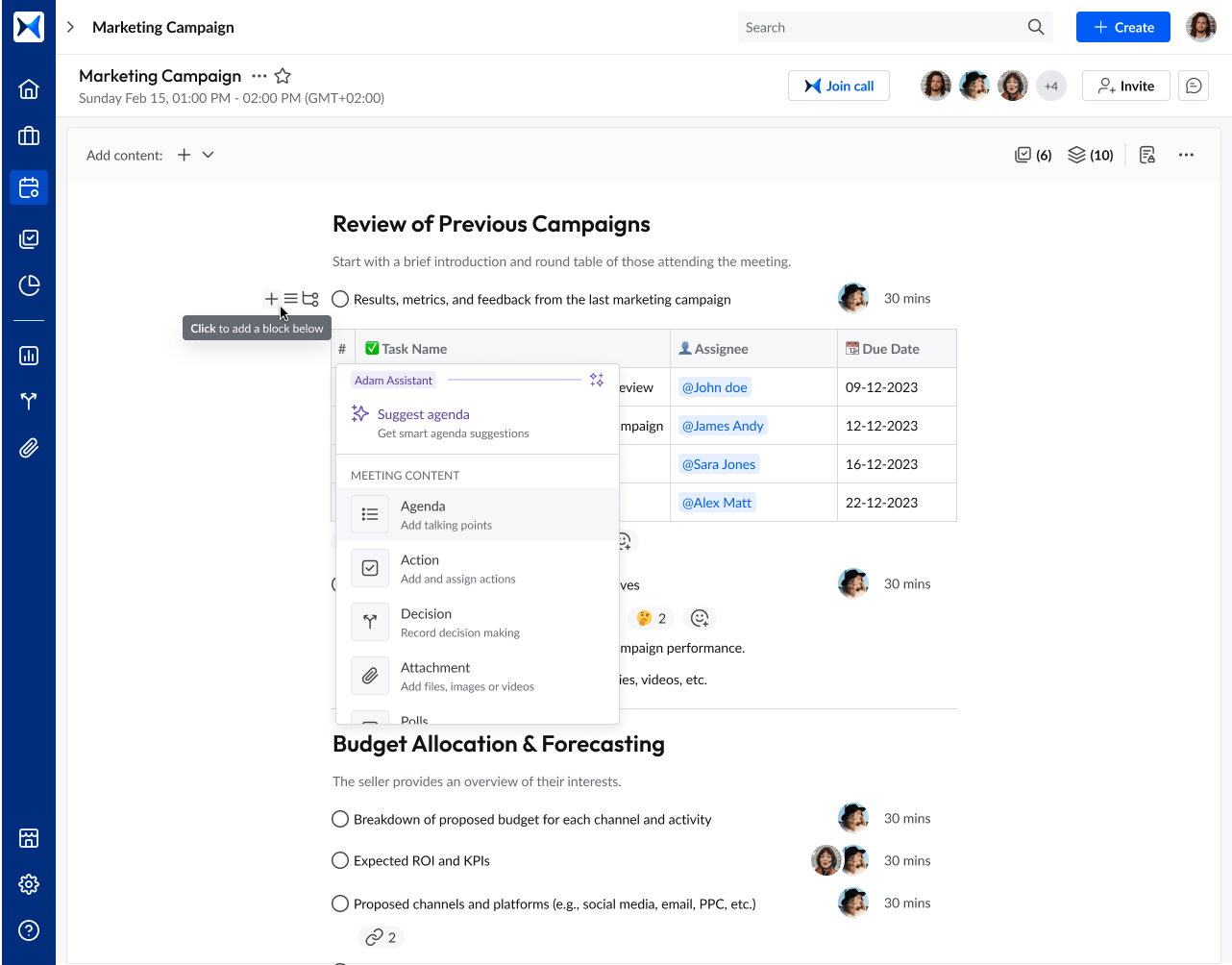
2. Action tracking
In educational partnerships, action tracking helps coordinate complex projects, such as joint research or curriculum development, and ensures timely follow-ups on agreed-upon initiatives.
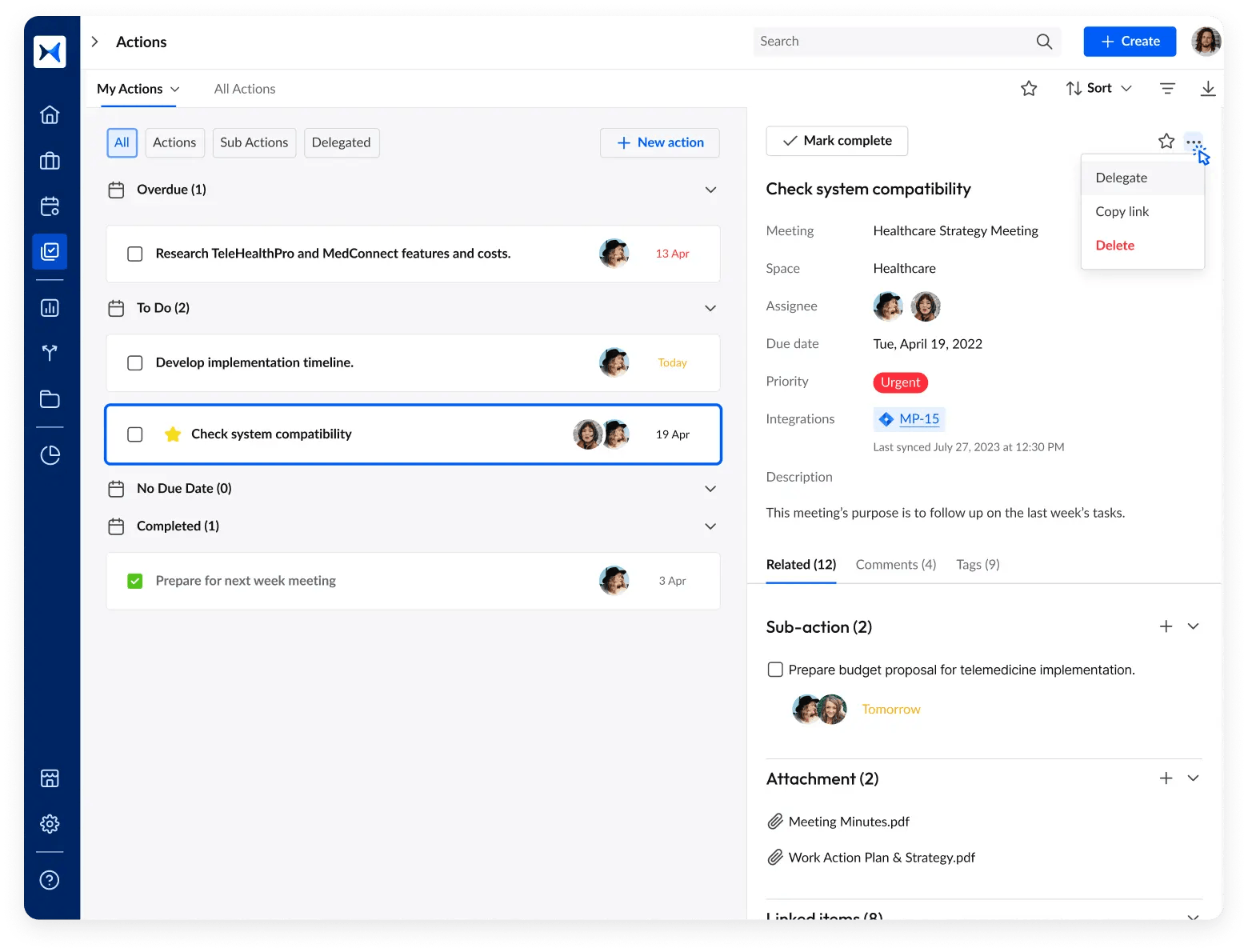
3. Content collaboration
Shared spaces for content allow institutions to co-create and store resources like proposals, research findings, or curricula. This feature fosters transparency and ensures all partners have access to updated documents, improving collaboration and minimizing miscommunication.
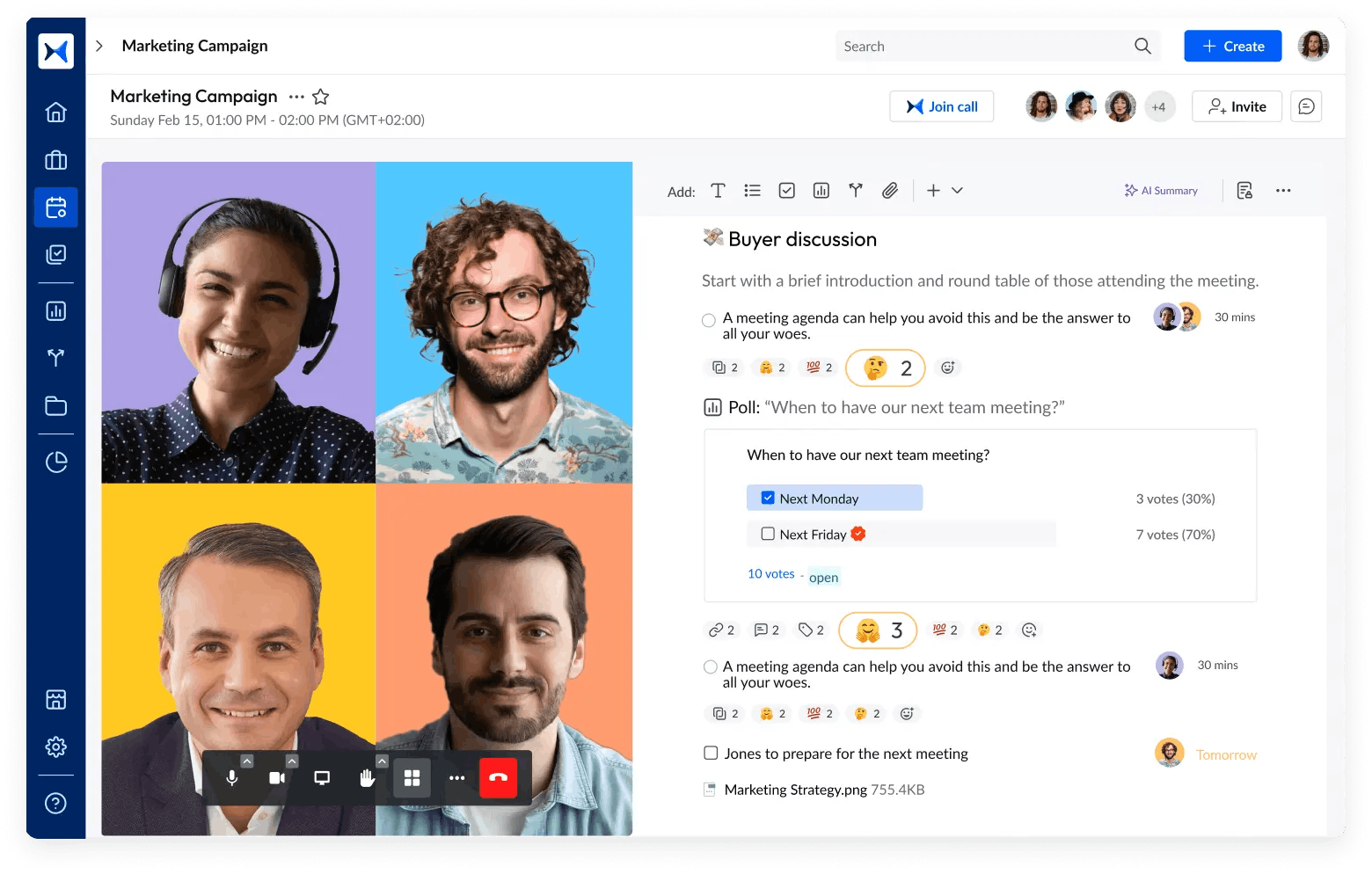
4. Polling
Polling enables quick decision-making by gathering input from multiple stakeholders. For partnerships involving diverse institutions, polling can simplify voting on key decisions, such as project priorities or resource allocation, ensuring inclusivity and efficiency.
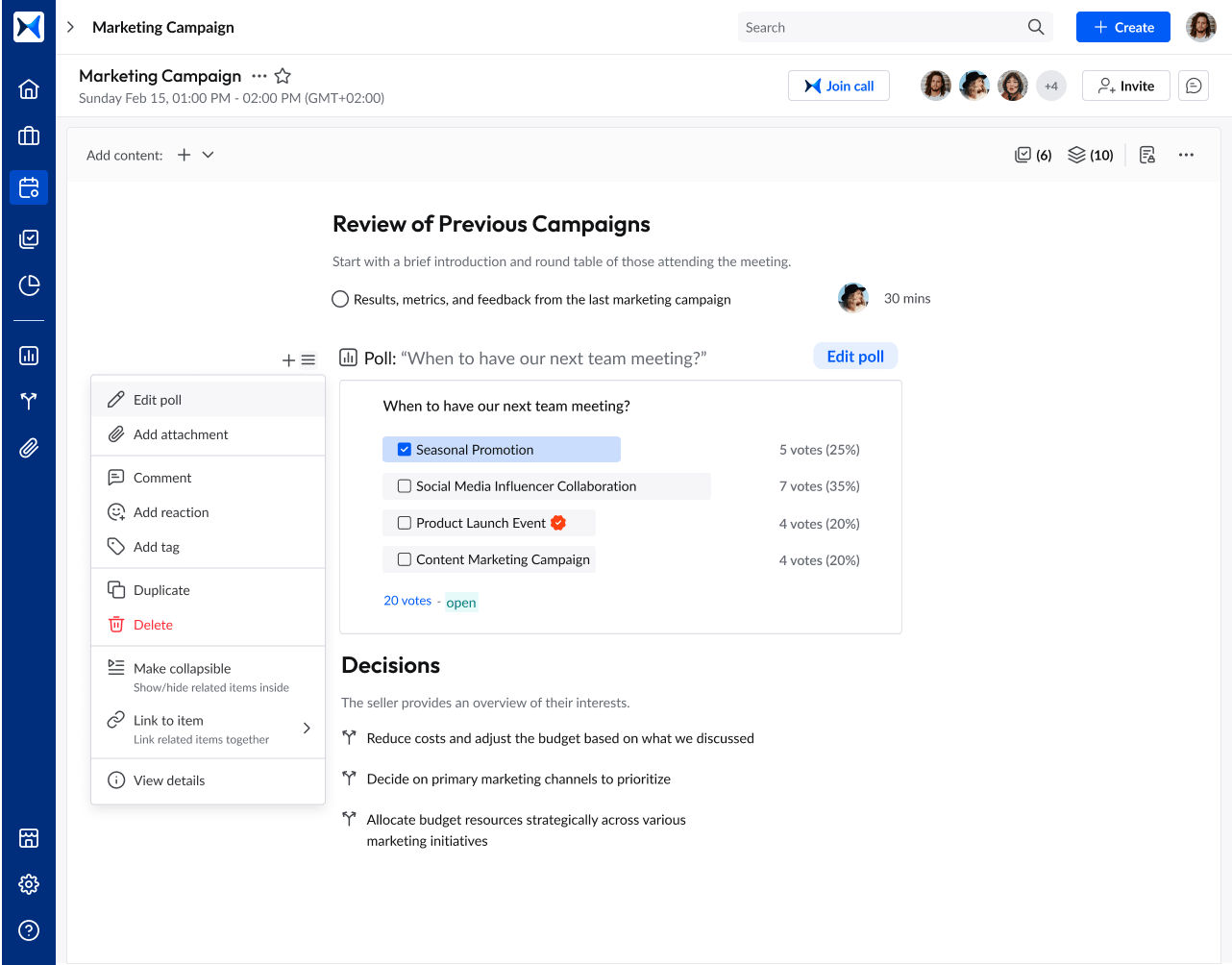
5. Meeting minutes
Accurate documentation of meeting discussions, decisions, and actions ensures that everyone remains aligned. This feature is crucial for educational partnerships, where long-term projects often require detailed records for continuity and accountability.
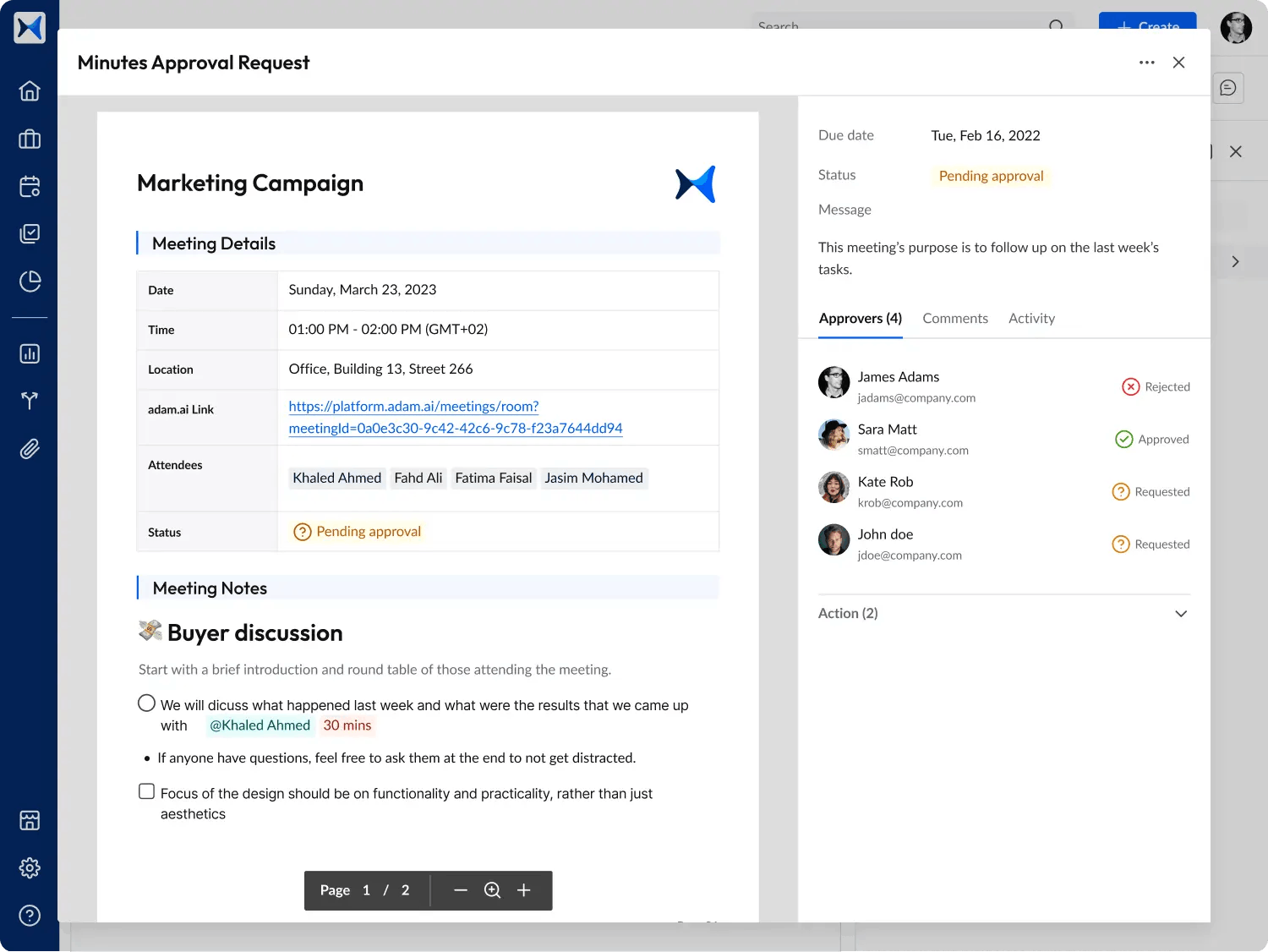
6. Analytical dashboards
Dashboards provide insights into meeting outcomes, project progress, and performance metrics. Educational institutions can use this data to evaluate the effectiveness of their partnerships, identify areas for improvement, and demonstrate impact to stakeholders or funding bodies.
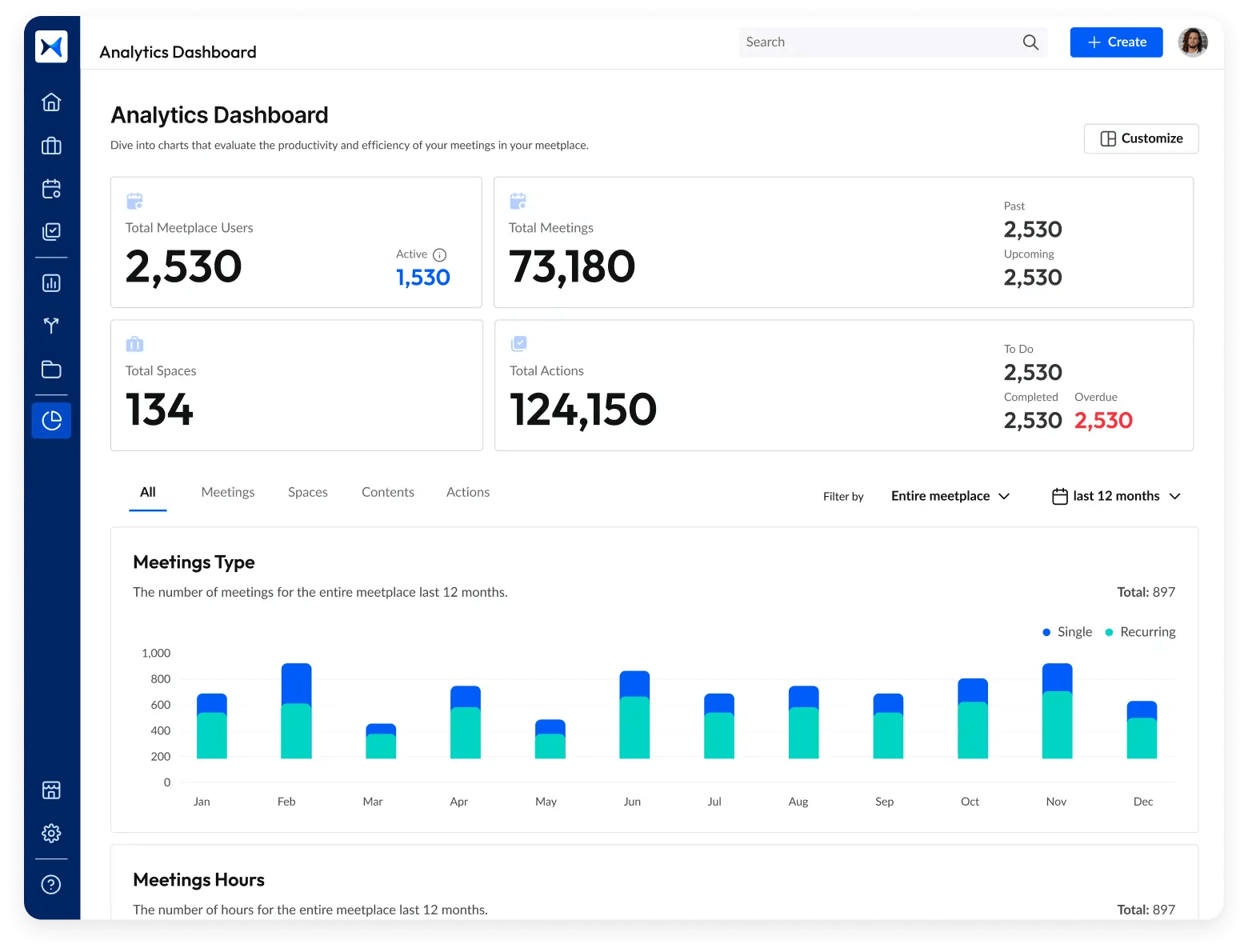
Transform how you conduct critical meetings—From meticulous preparation to effective execution and insightful follow-up, adam.ai integrates comprehensive analytics, full customization, and intuitive interfaces with powerful meeting management tools.
Easy onboarding. Enterprise-grade security. 24/7 dedicated support.
The bottom line
Building collaborative educational partnerships is more than a strategy; it's a necessity for navigating the complexities of modern education. By embracing best practices and leveraging modern tools, institutions can create partnerships that drive lasting impact and elevate learning experiences.
And while there may be multiple solutions available, here is why adam.ai is the meeting management software platform you can trust:
- adam.ai is one of Atlassian Ventures' portfolio companies.
- In the meeting management software category on G2, adam.ai has been ranked a leader and a high performer for successive quarters in the past years.
- adam.ai has been included in the Forrester Report in the AI-enabled meeting technology landscape.
- adam.ai is trusted and used by powerful teams and organizations worldwide for all types of critical meetings, like board, committee, project management, and business development meetings.
- And most importantly, adam.ai integrates with your existing workflow, is SOC2 compliant, provides dedicated support and success, and has a free trial option.
Subscribe to adam.ai blog
Stay ahead with the latest insights—get our newest blog posts, tips, and updates sent straight to your inbox.